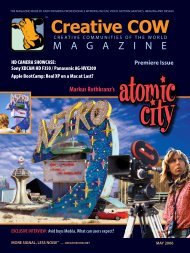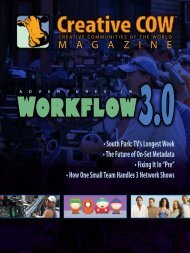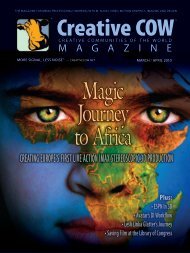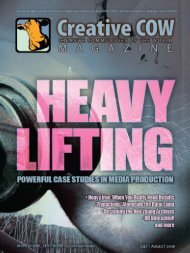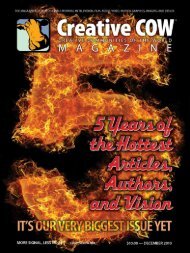Create successful ePaper yourself
Turn your PDF publications into a flip-book with our unique Google optimized e-Paper software.
Tim: I was struck by your earlier example of following<br />
the degrees of the angles that the camera moves<br />
through during a shot.<br />
Dave: Yes, on a frame-by-frame basis. Because the<br />
visual effects people then have to take whatever pictures<br />
you’ve created at 24 or 29 or 120 frames per second,<br />
put them into a tracker, Boujou or PFTrack or who<br />
knows what, and solve for movements including dolly<br />
and tilt, focus, zoom, boom, swing, track and everything<br />
else that goes into a shot. It’s a horribly complicated<br />
equation to figure out after shooting.<br />
Yet in the grand scheme of things, that’s a minuscule<br />
amount of data to collect while shooting. You only<br />
have to remember to ask, “O’Connor, the next time<br />
you build a pan head, we want it with a plug for a data<br />
recorder.”<br />
Or “Panavision, do you have a GPS set that you<br />
can build into the base plate?”<br />
GPS apparently takes very little real estate because<br />
it’s there in my iPhone sitting on my desk.<br />
[Laughter]<br />
Gary: I look at it from the post side. Cooke Optics has<br />
this little box, the “/i dataLink.” It records focus, zoom<br />
and all that from the lens, and then everything from<br />
the camera too. It records all that to this little SD card.<br />
Now you have the actual data. Instead of having<br />
to recreate it, you can do motion matching and everything<br />
in VFX long before the footage itself actually<br />
gets there. There’s not somebody waiting for the footage,<br />
and then starting to do all this work manually for<br />
weeks and weeks on end.<br />
22<br />
Dave: Exactly. This is the classic mistake that studio<br />
bean counters make. “We need to get the budget<br />
down, so let’s beat this guy up for more of his wages.”<br />
Instead, for a shot that used to be a Boujou problem,<br />
you create a sync frame, like the bloop on the<br />
slate. Now comes the rest of the data: here’s the center<br />
shutter open pulse, here’s the pan, tilt, focus, zoom, fstop,<br />
dolly, boom — synchronized with every frame of<br />
the film that you shot.<br />
The artist who would have spent six weeks tracking<br />
this out by hand, and reverse engineering camera<br />
position and focal length anecdotally or from someone’s<br />
handwritten notes, can now simply take the<br />
metadata file, plug it in and start doing the work. The<br />
real work.<br />
This is the way that I love to frame the discussion,<br />
as an invitation to the producers and the studios<br />
who want to save money. You know, we can all stand<br />
around and haggle over 50 cents an hour for every employee<br />
on the staff and you can feel like you’ve saved<br />
some money.<br />
Or we can automate those people’s work, get it<br />
done in a week’s less time or a month’s less time, and<br />
then save some real money.<br />
Everyone asks, well, who’s going to pay for developing<br />
all of this new automated metadata collection?<br />
I say, we already pay for it anyway. How often do you<br />
buy computers and cameras and lenses? We renew and<br />
replenish this stuff on a daily basis. At least ask manufacturers<br />
for what you want in the updates, rather than<br />
just taking what you’re handed.<br />
METAPAPER<br />
Dave: One of the obstructions to automating<br />
the motion picture workplace is<br />
that we don’t have a tradition of metadata<br />
on set. We have a tradition of what I call<br />
“metapaper.”<br />
For example, script supervisors for the<br />
most part take a paper copy of the script,<br />
and note vast quantities of metadata in<br />
real time just by watching the movie being<br />
filmed: script changes, which actors are in<br />
each shot, and so on.<br />
And they notate that using lines and<br />
squiggles and arrows and notes all over<br />
the typed script, with hand written notes<br />
to elaborate. They accumulate vast quantities<br />
of paper that people have to keep in<br />
notebooks.<br />
The first assistant and the second assistant, all<br />
the cameramen, the loader — these people keep vast<br />
amounts of paper notes too. If you want to know what<br />
lens they were shooting with, or if you want to know<br />
what filters were on the camera or what settings they<br />
shot with, you have to dig out that notebook and find<br />
<strong>Creative</strong> <strong>COW</strong> <strong>Magazine</strong> — September / October 2008



